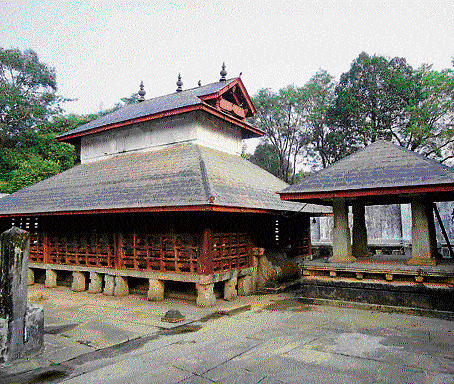
Most places in Udupi district are wide off the tourist trail. Yoginder Sikand discovers Barkur, a town with a rich past. He also visits the gigantic Mekekattu Nadikeshwara temple, which houses dozens of brightly-painted wooden statues.
I have no idea why—although this may actually be for the good—but the State’s Udupi district is wide off the well-beaten tourist trail. That’s what I discovered on a recent visit to the area. A rattling country bus dropped me off at Barkur, a half-hour drive from Udupi, after crossing three broad rivers bordered by forests of coconut trees, down which country-made boats lazily floated.
Today, Barkur is a quiet, unassuming village, but it was once the thriving capital city of the Tulu kings, whose empire covered much of coastal Karnataka. Barkur was also ruled by the Cholas, the Nayakas, the Vijaynagar kings, the Hoysalas, the Alupa dynasty and Tipu Sultan.
Once home to 365 temples!
Barkur’s rich past is now largely forgotten, preserved only in the form of several imposing temples, some of them almost a thousand years old, the ruins of two forts and numerous royal stone inscriptions scattered in and around the village. Barkur, so it is said, once boasted 365 temples, and, according to local legend, the town’s ruler would pray in a different temple every day, one for each day of the year. Today, only a few of these temples remain—some of them grand architectural marvels.
I sauntered through palm groves and paddy fields, dotted with coastal-style slanted roof bungalows, as I went about exploring the ruins of Barkur. Some of these are in a state of advanced ruin and pathetic neglect, though others are still remarkably well-preserved and are certainly well worth a visit.
There is enough in the village to see, to keep you occupied for half a day, particularly dozens of temples. These are mostly built in unique coastal Karnataka style, with slanted, multi-layered roofs, supported by richly decorated stone pillars that depict a host of deities, and surrounded by pillared corridors. Delicate carvings decorate the walls.
Gigantic, carefully-carved wooden chariots are parked in palm-leaf-roofed garages, to be taken out on festive occasions.
It is quiet and cool inside the temples—just the perfect ambience to reflect and to drink in the silence.
A lone pujari rings a brass bell, lights an oil lamp and places a hibiscus flower at the feet of a statue. Birds hop about in the trees, and in the distance you hear the tinkling of a cow’s bell.
Turtles laze in lily ponds in the temple compound. Time, you think, has completely stopped, and there’s nothing more that you’d like to do than to sit hours here doing nothing but watch the clouds float by.
Mekekattu Nadikeshwara
Spending that morning at Barkur, I headed to a nearby forested grove, to visit the gigantic Mekekattu Nadikeshwara temple. It houses dozens of brightly-painted wooden statues, some of them 10 feet in height. These depict a range of local deities.
Others represent animals, humans, and mythical creatures, and many of them look fierce. Some of them are dressed like soldiers, suggesting that they might have been originally made to commemorate a war. Some even hold a replica of an old gun or a sword, posed as if ready for battle.
Not far from Barkur, and an hour’s bus-drive from Udupi, is the relaxed, laid-back town of Kundapura. Unplanned urban ‘development’ has wrought havoc here, as elsewhere in India. Delightful traditional coastal-style bungalows have been torn down, to be replaced by ugly houses painted in electric colours, but many of the earlier buildings still remain. Buses zip down the busy highway, where just two decades ago bullock-carts lazily trundled past.
Back to a different era
There’s nothing really to see in the town, but if you venture just off the main road you’ll feel you’ve been transported back to a different era altogether. Paddy fields are bursting with a rich crop, ready to be harvested. Hens and goats saunter about outside quiet village houses.
And then, an hour’s walk later, you arrive at a spotlessly clean beach that stretches as far as you can see on either side. You can spend hours here in blissful silence, watching the restless sea tossing and turning about, the crabs playing hide-and-seek in the rocks, a pack of herons taking a stroll on a bar of sand, and starfish swimming in little pools. You might, if you are fortunate enough, be able to coax the local fisherfolk to let you accompany them into the sea.
There are numerous temples, many of them centuries-old, around Kundapura that shouldn’t be missed: Koteshwara, with its enormous tank filled with gigantic fish, Anneguddi, with its Ayurvedic ashram and a gurukul where boys are trained in wooden and metal craftwork, and the Shankaranarayana temple, nestled in a dense forest, with its exquisite brass statues and stone carvings, and where the traditional Yakshagana form of dance is still performed.
You could, if you have the time, drop in, as the sun slithers down the horizon, at Gangolli village to watch gaily-painted fishing boats return to the harbour laden with the day’s catch. If you are a passionate vegetarian, however (as I am), you might wisely choose to avoid the place: It might be impossible for you to bear the sight of piles of live fish being heaped into baskets with spades and thrown into waiting trucks waiting to transport them to wholesale markets in and beyond Karnataka.
For nature lovers, this part of Karnataka still has patches that remain unspoiled — quiet beaches that, mercifully, tourists haven’t yet discovered and invaded; numerous palm-ringed rivers; several beautiful backwaters that can be explored by boat; and the densely-forested hills of the Western Ghats, a trekker’s delight.